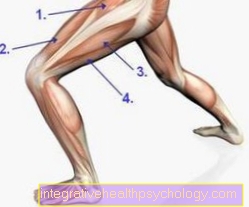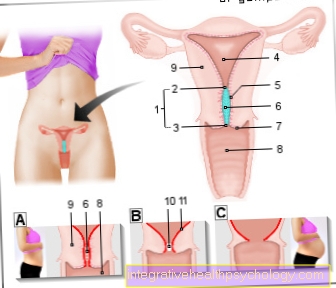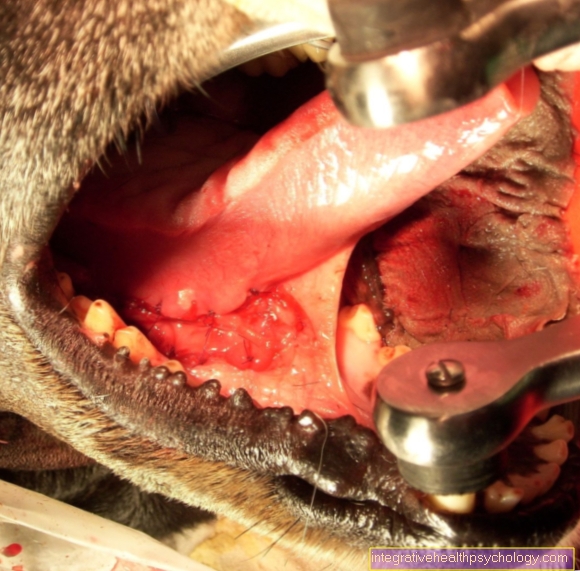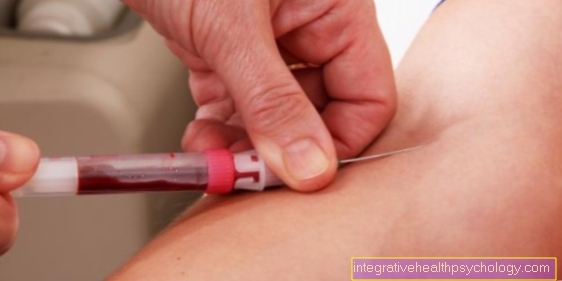The causes of swollen ankles
introduction
Swollen ankles can have a number of causes. In individual cases, it is therefore important to look carefully to see which physical problem led to the severity of the swelling. In any case, those affected should realize that swollen ankles are a warning symptom, as they do not occur in a healthy person.
Depending on the combination with other symptoms, they can point to an acute overload of the joint or even to a serious underlying disease. If the swelling persists, a doctor should therefore be examined.

The typical symptoms
- Pain
- pulsating pain especially with a torn ligament
- dull pain especially for tendon or cartilage irritation
- Function / movement restriction
- Redness
- bruise
- c-shaped effusion under the ankle with a torn ligament
- uniform effusion with an external impact
- overheat
- swelling
- doughy swelling with edema
- Movable fluid depot in the event of bleeding or fluid storage in the capsular tissue of the joint
- firm swelling with a pronounced hematoma
- decreased resilience
- accompanying fever with an infectious cause
- Difficulty breathing during physical exertion (exertional dyspnea) in the case of heart failure
The weak heart
With heart failure, swollen ankles are a common symptom. They are caused by the reduced pumping capacity of the heart, which causes the circulating blood volume in front of the heart to build up.
If the build-up is very pronounced, liquid is “pressed” from the vessels into the surrounding tissue. Those affected clinically notice the fluid retention as swelling (lat. Edema). The fact that the ankles in particular are affected by swelling is due to pure gravity. When standing, it is highest in the legs.
The symptoms of heart failure? Read more about this.
The protein deficiency edema
Protein deficiency edema can also cause swollen ankles, although it does not characteristically cause this symptom. A “bloated” belly, which arises as a reaction to a lack of protein, is typical. If the protein albumin is missing, it cannot fulfill its function of holding the liquid in the vessels. As a result, liquid leaks into surrounding structures. Since a particularly large number of vessels run in the abdominal area, this is where the discharge of liquid is highest and a deceptively round, plump belly is formed.
Nevertheless, there is also edema in the ankle area, which, however, is much less pronounced in comparison.
Read more about the topic here: The protein deficiency edema.
The varicose veins
Varicose veins are dilated vessels which, due to their abnormally changed valves, can no longer adequately transport blood to the heart. Strictly speaking, the closing mechanism in these enlarged vessels no longer works, so that the blood sinks back down towards the feet under the force of gravity.
The larger the filling volume of the varicose veins, the leaky the vessel wall becomes and more fluid is pressed into the surrounding tissue. Those affected notice this through swelling of the ankles and sometimes even the lower legs.
You can find more information at: The varicose veins.
The drugs
Medication can cause swollen ankles as a side effect. Blood pressure drugs and hormone preparations are particularly well known for this side effect. In the case of blood pressure drugs, it is mainly calcium antagonists such as amlodipine that cause the vessels to widen in order to lower blood pressure. The hormone preparations are mainly drugs with an estrogen content that are used, for example, as part of hormone replacement therapy during menopause or in various anti-baby pills.
In general, however, if ankle swelling occurs in connection with taking a new medication, the patient information leaflet should be read and the attending physician informed.
The heat
When it is very hot, the body tries to regulate its own heat by widening the blood vessels. The principle behind this measure is to be able to release more heat to the outside by increasing the surface area of the vessels. This usually works very well because many vessels run superficially.
If the vessels are excessively widened, however, the circulation of the blood is impaired and as a result the blood accumulates in the vessels. With increasing filling, the vessel wall becomes more permeable and fluid escapes, which can be observed as swelling. According to the force of gravity, this occurs preferentially on the legs.
The thrombosis
A thrombosis is a blood clot that blocks a vessel. Due to the occlusion, blood congestion occurs in the affected vessel and the vessel wall is stretched by the volume. As the degree of expansion increases, the vessel wall becomes more “holey” and fluid escapes into the surrounding tissue.
If a vessel in the lower leg is closed, however, in addition to swelling in the ankle area, there is also swelling in the lower leg area. Typically, this is accompanied by overheating and reddening of the affected leg.
Further information on this topic can be found at: The thrombosis in the leg.
The inflammation
Inflammation in the ankle can easily cause swelling in the ankle area. It does not matter from which structures the inflammation originates - both an irritation of the ligaments and an overstrained joint surface can cause the classic symptoms of inflammation, "swelling, pain, reddening and functional impairment". An inflammatory reaction of the body leads to a permeability of vessels and to a sensitization of the nerves. For this reason, liquid can escape from the vessels and collect outside. Excessive use only causes temporary swelling.
If the joint partner is incorrectly positioned, it persists - consequently, every movement or load creates a new inflammatory stimulus. In this case, orthopedic treatment is required.
The insect bite
In order for the ankle to swell in the event of an insect bite, it must be in the vicinity. A swelling over the ankle is primarily a locally related symptom as a reaction to the insect venom or the insect saliva.
As part of the body's own defense against the insect bite, inflammation is triggered in the directly surrounding tissue, which manifests itself in swelling, reddening and overheating. However, depending on the sensitivity of the person concerned to the insecticide, the swelling can spread further and be accompanied by other symptoms.
Also read the article: The insect bite.
The allergy
Not every allergy can be the cause of ankle swelling. An insect bite in the case of an insect venom allergy is quite conceivable as triggering swelling in the ankle area if the bite is near the ankle. A hay fever allergy, for example, does not cause swelling of the ankles. Classically, the mucous membranes in the nasopharynx swell here.
However, if an allergic shock occurs as part of an allergic reaction, the body develops a generalized tendency to edema. This means that in addition to swelling of the ankles, global fluid storage takes place here.
The symptoms of an allergy? Find out more about this here.
The chemotherapy
In chemotherapy, it is usually not the chemotherapy drugs (cytostatics) but the administration of cortisone that are the cause of the swelling. Cortisone is known to cause increased storage of fluid in the tissue. However, this side effect is accepted as it is anti-inflammatory and prevents nausea, which is often triggered by cytostatics.
For more information, see: The side effects of cortisone.
The injury
In the area of the ankle, the most common mechanism of injury is "twisting", which can lead to ligaments overstretching or even tearing. In the worst case, even the bones are affected.
Swelling can be caused by hemorrhage or a local inflammatory reaction caused by the accident mechanism. Experience has shown that the swelling is more pronounced, the more serious the injury. If the ankle swells significantly within seconds, at least one crack in a joint structure can be expected, which requires medical treatment.
The burst Baker's cyst
A Baker's cyst is an accumulation of fluid in the joint capsule of the knee, typically located in the hollow of the knee. When the cyst opens, the fluid leaks and spreads towards the ankle according to gravity. However, swelling of the ankle itself is not characteristic. Rather, it is to be expected that the fluid will spread in the boxes between the lower leg muscles and lead to aching pain there. In addition, the amount of fluid is usually only small, so that opening the cyst only releases a few milliliters.
Swelling is usually only to be expected locally in the area of the knee joint.
This article might also interest you: The Baker cyst.
The attack of gout
In theory, a gout attack can cause swelling in the ankle. However, the ankle is not the classic joint that hurts during a gout attack. The metatarsophalangeal joint of the big toe is affected much more frequently.
However, if the excess uric acid accumulates in the ankle, it also leads to immense inflammation here, which can also manifest itself in painful swelling.
The lymphedema
In the case of lymphedema, fluid stored in the tissue cannot be transported away via the so-called lymph vessels. As a result, more and more fluid accumulates and the affected extremity increases in size. Swelling of the ankles can therefore be caused by lymphedema. It is important to clarify in each individual case whether it is a congenital or acquired disorder and whether it is reversible or irreversible.
The therapy of choice is lymphatic drainage and compression treatment in the form of stockings or tights.
Find out more about the topic here: The lymphedema.
The hamstring of the calf
A torn calf muscle fiber can lead to swelling of the ankle, depending on the extent of the muscle injury. Small tears tend to lead to local bleeding into the muscle, which usually only leads to swelling of the calf. However, if the muscle fiber tear is so large that the inflammatory reaction is pronounced, swelling of the ankle can also occur.
The reason for this is that the increased blood flow in the area of the tear also releases more fluid into the tissue. If a lot of fluid migrates down the muscle boxes, it eventually collects in the area of the ankle and leads to an increase in circumference there.
The broken bone
When a bone fracture in the area of the ankle joint, there is almost always swelling of the ankle. When bone structures break, blood vessels are usually injured as well. The result is bleeding into the tissue. This is enough to cause the ankle to swell.
Another aggravating factor is that the injury induces an inflammatory reaction, which is accompanied by increased blood flow and additionally increases the swelling.





























